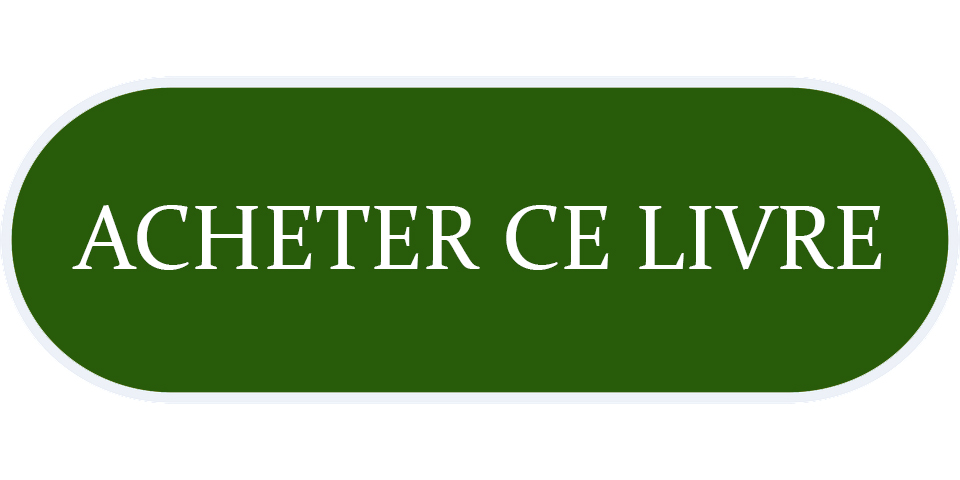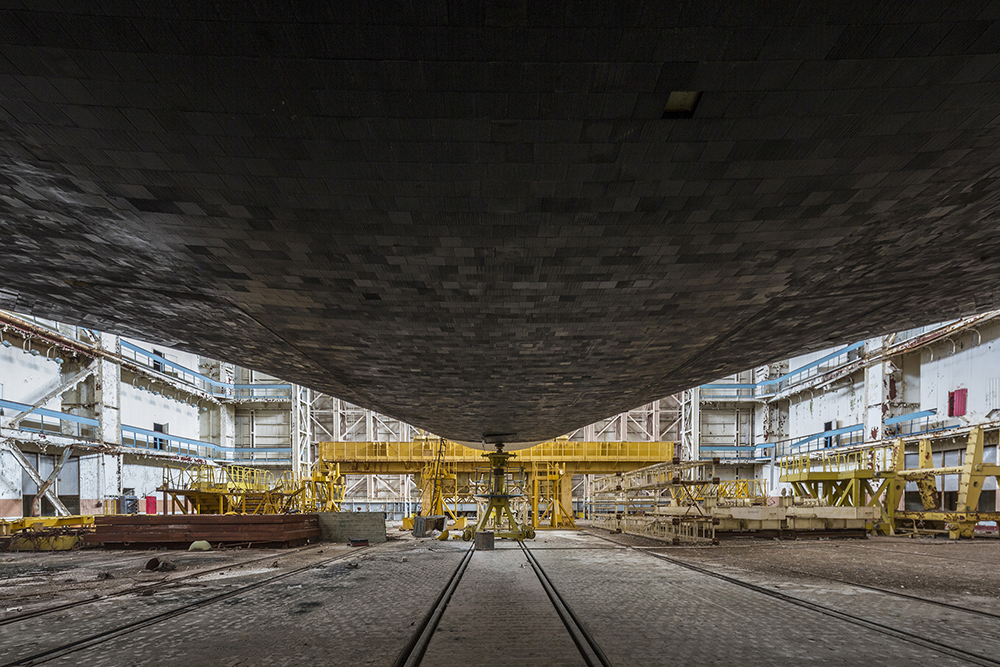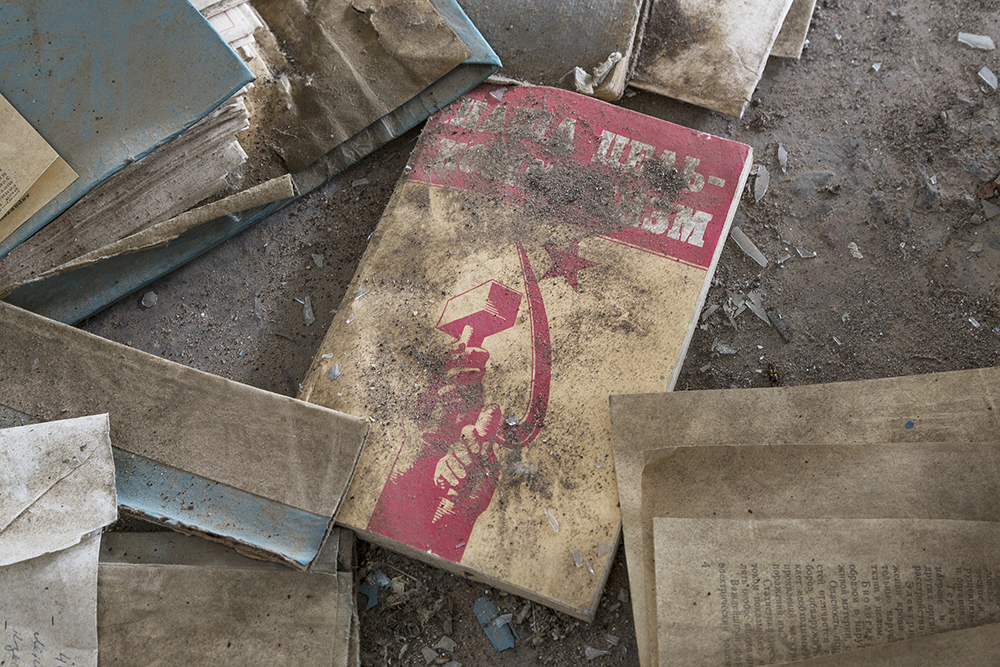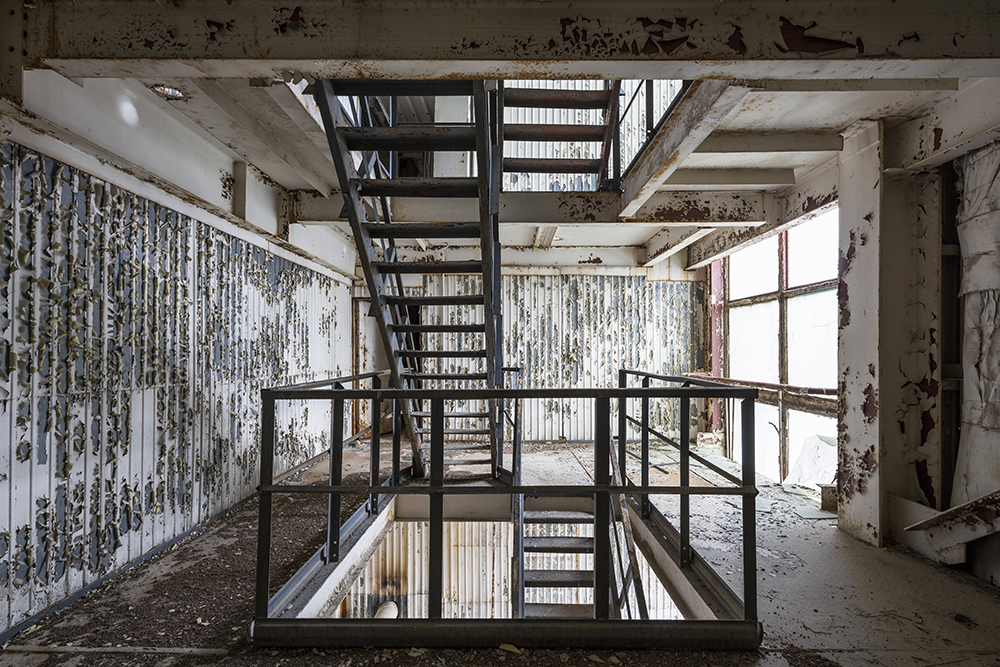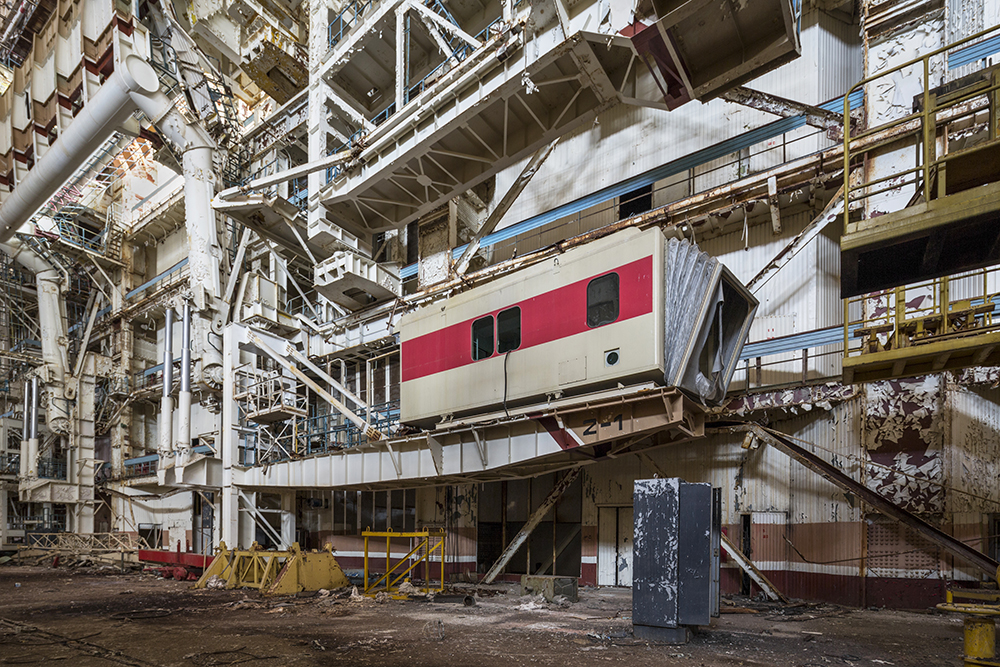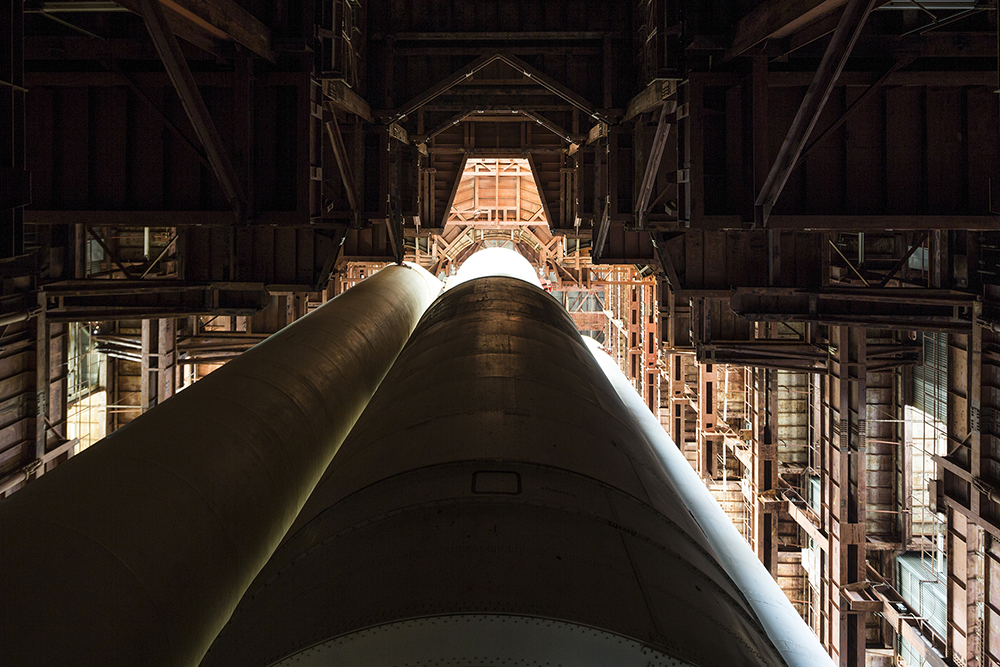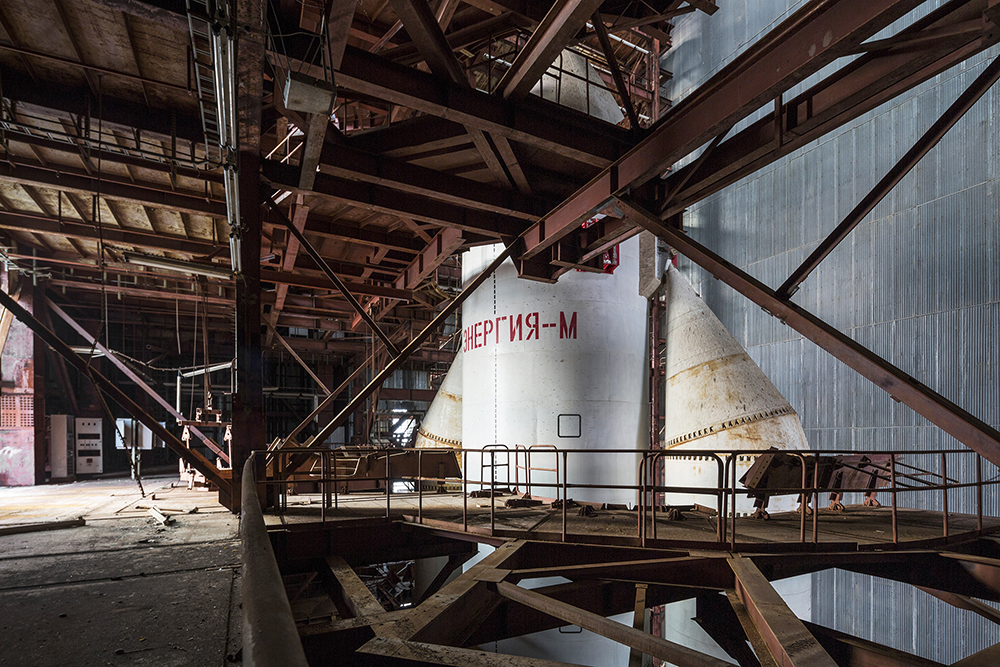

English version
Version française
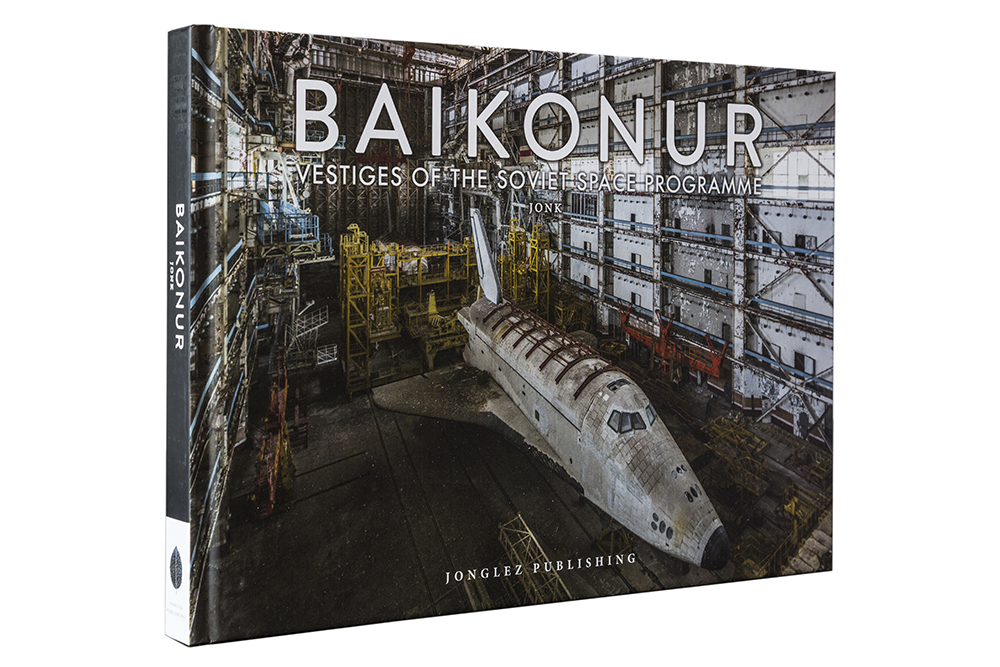
- Hardcover – 192 pages
- Publisher: Jonglez Publishing
- Language: English
- Size: 29.7cm x 21cm
- ISBN: 978-2-36195-377-5
Released in October 2019.
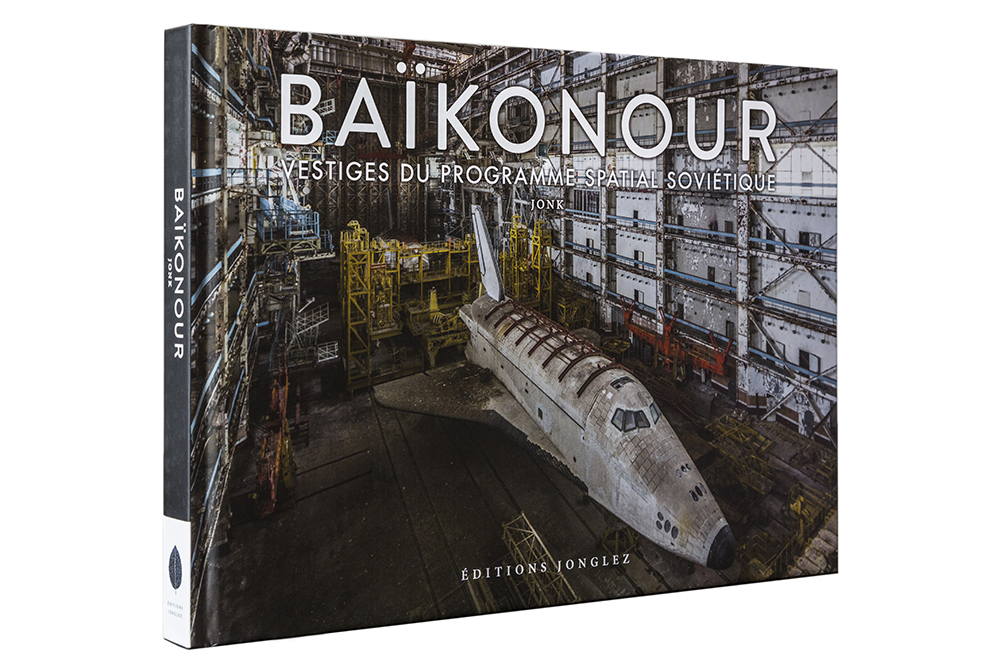
- Couverture rigide – 192 pages
- Editeur: Editions Jonglez
- Langue: Français
- Taille: 29.7cm x 21cm
- ISBN: 978-2-36195-376-8
Sorti en october 2019.
“The Earth is the cradle of humanity, but who wants to spend his life in a cradle?” — Konstantin Tsiolkovsky
The Baikonur Cosmodrome in Kazakhstan was created by the Soviets in the 1950s. It was from Baikonur in 1988 that the first Soviet spaceplane, Buran, was launched, in response to the United States Space Shuttle.
The Buran programme would officially end in 1993 during the presidency of Boris Yeltsin, with only one Buran launch ever taking place — in 1988. Thereafter, parts of the Baikonur Cosmodrome fell into disuse, notably the sites connected with the launch of these Soviet craft. The two shuttles that were completed remain abandoned there,
laid to rest in this atmospheric place.
This is the first time that photographs of these spectacular locations have been published in a book.
Jonk travelled 20km through the Kazakh desert under cover of night, entered the hangars clandestinely, and spent three nights there under the radar of military security to produce a truly incredible photographic reportage of what is considered today the world’s most important urban exploration site. Jonk reveals to us his excellent collection of photographs taken in the disused part of the Baikonur Cosmodrome. As well as providing us with these amazing pictures, he describes for us the incredible adventure of visiting a location that is unique in the world.
« La Terre est le berceau de l’humanité, mais qui a envie de passer sa vie dans un berceau ? » — Konstantin Tsiolkovski
Le site spatial de Baïkonour, dans l’actuel Kazakhstan, a été créé par les Soviétiques dans les années 1950. C’est de Baïkonour que fut lancée en 1988 la première navette spatiale soviétique, du nom de Buran, concurrençant ainsi la navette spatiale des États-Unis.
Le programme Buran sera officiellement arrêté en 1993 par Boris Yeltsin, le seul et unique vol de Buran ayant ainsi eu lieu en 1988. Depuis, le cosmodrome de Baïkonour a été partiellement abandonné, et notamment les sites liés au lancement de la navette spatiale soviétique. Les deux navettes spatiales qui ont été construites y reposent désormais, à l’abandon, dans une ambiance inouïe.
C’est la toute première fois que des photos de ces sites absolument exceptionnels sont publiés dans un livre.
Jonk a parcouru de nuit 20 km dans le désert kazakh pour rentrer en fraude dans ces hangars où il a dormi 3 nuits, échappant aux rondes des militaires qui sécurisent l’espace pour créer un incroyable reportage photographique sur ce qui est considéré comme le site d’exploration urbaine le plus mythique du monde. En plus de nous révéler son excellente collection de photographies prises dans les parties abandonnées du Cosmodrome de Baïkonour, Jonk nous décrit l’incroyable aventure qu’a été la visite de ce lieu unique au monde.

“Jonk is a veteran urban explorer, or “urbexer,” who estimates he’s photographed around 1,500 abandoned places around the world. But few places were more difficult to access than the Buran hangar.” Wired
“Christmas is also a time for remembrance, for travelling down memory lane, when we routinely look back at semi-forgotten times, people and places. Here, I cannot fathom a better Christmas present than ‘Baikonur: Vestiges of the Soviet Space Programme’. Creating this unique album required extreme ingenuity and bravery on the part of its author, the writer and photographer Jonk. He travelled 20km through the arid Kazakh desert and, having reached Baikonur, snuck into the hangars with the abandoned spacecraft, which included two space shuttles. Covertly, he spent several days in the former Cosmodrome taking photos while avoiding armed guards. The results are truly breathtaking. The sad, yet highly artistic, pictures of the abandoned and often crumbling remains of the giant Soviet space project’s technology and infrastructure carry an important emotional and philosophical message: even the most daring technological ambitions inevitably turn to dust if they’re carried out as a political showcase, staged and guided by a totalitarian state to the detriment of its own people.” Engineering and Technology
“The two space shuttles that were built now rest there, abandoned, in an irradiated atmosphere. This is the very first time that photos of these absolutely exceptional sites have been published in a book. Jonk traveled 20 kilometers in the Kazakh desert at night to smuggle himself into these hangars where he slept for three nights, escaping the rounds of the soldiers who secure the place. An unimaginable photographic report in what is considered today the most important Urbex (urban exploration) site in the world. This exceptional report on a secret site, documented at the cost of all risks, takes us to the heart of Kazakhstan, to the Baikonur Cosmodrome which was the space flagship of the USSR. The Berlin Wall falls, the Cold War ends, the Soviet space program no longer has funding, the part dedicated to shuttles falls into disuse… A journey back in time to places haunted by the space race that the USA and the USSR engaged each other. Spectacular and unusual, an exceptional book.” Artistik Rezo (translated from French)
“The volume “Baikonur: Vestiges of the Soviet Space Program” tells the story of the Buran and the adventure of its rediscovery in magnificent pictures. It takes the reader to the artifacts of the Soviet space program – among all the lost places in the world, the Buran’s grave occupies a special place.” Stern (translated from German)
“He described the entire difficult and dangerous expedition in his latest album “Baikonur: Vestiges of the Soviet Space Program,” which went on sale in November this year, in which, in addition to exceptional photos – a description of the adventures that met him along the way. Jonk shows the power of what was created, which for some has sunk into oblivion, and for others is a monument to the ever-living power of the past. Especially since after great fame came oblivion.” Onet Culture (translated from Polish)
“Rise and fall. For forty years, Baikonur, in Kazakhstan, was the center of the Soviet space program, before being partially deserted. An ideal playground for photographer Jonk, a specialist in urbex (the exploration of abandoned spaces). It’s all there: gigantism, Soviet aesthetics and the beauty of decayed places, where peeling paint becomes an abstract landscape… The globetrotter takes the reader with him on his adventures in the heart of the Kazakh desert.” Ideat (translated from French)
“Jonk’s photographs of Baikonur emanate a sense of loneliness, of a vanished past and decrepitude. At the same time, there’s a sense of past splendor, a real impetus towards progress, even if today it may seem a little outdated. It’s impossible to remain indifferent to these moving testimonies to the conquest of space, which was the stuff of Western dreams for almost half a century. Jonk’s adventure also remains in the mind when we realize the risks incurred by the fine team of the Baikonur expedition. The authorities, the cold, the impossible-to-measure danger of being arrested and taken to prison – nothing stopped the photographer whose boundless curiosity is a vector of creativity. It’s pleasing to note that urban exploration never takes precedence over the quality and aesthetic research of Jonk’s photographs.” Beware (translated from French)
“Frenchman Jonathan “Jonk” Jimenez, who has documented more than 1,500 abandoned sites in 50 countries, recently embarked on the most ambitious journey of his extensive photographic portfolio: a visit to the ruins of the Soviet space program at the Baikonur cosmodrome in Kazakhstan. And the result of his impressive images could not contrast more radically with the decay of the place he recorded: the photographs show abandoned, vandalized rockets, looted of valuable metals, historically relevant documentation forgotten in offices frozen in time, buildings that have been stripped of habitable and functional conditions for decades.” P3 (translated from Portuguese)
“The photographer Jonk is a specialist for abandoned places. In Baikonur he landed a coup, he managed to get into the mausoleum of the Soviet space shuttle Buran and photograph there the last triumph of Soviet space travel. Jonk’s volume “Baikonur: Vestiges of the Soviet Space Program” tells the story of the Buran and the adventure of rediscovering it in great pictures.” Archyde
“Today, Baikonur is considered the most important urban exploration site in the world. To photograph the Baikonur cosmodrome, Jonk traveled 20 km across the Kazakhstan desert at night. The photo report was made after sneaking into the abandoned hangars and spending three nights inside the abandoned cosmodrome to produce the volume “Baikonur, Vestiges of the Soviet space program.” Jonk’s photographs bear witness to the allure of the disused part of the cosmodrome and reveal the allure of the decay of this abandoned space, flanking the images with descriptions of the incredible adventure of visiting a truly unique place.” Fanpage.com (translated from Italian)
“When the flashlight finally shone on Buran, I gasped,” Jonk recalls. I will always remember the sight of Buran abandoned in the dark like that. Of all the abandoned places I’ve explored, this is by far the most memorable,” Jonk said. He also snuck into a nearby hangar where a prototype of the Energia M rocket, once used to launch Buran, is stored. For Jonk, who has long been fascinated by Soviet relics, the trip was truly a career highlight. His hope is that these surviving shuttles will eventually be rescued from their current state of neglect and given the respect they deserve.” Wired Japan (translated from Japanese)
“October 2019 sees the release of an extraordinary book by photographer Jonk: Baikonur. This 192-page book of text and photos is simply incredible and unprecedented: it literally plunges you into the remnants of the Soviet space program, and more specifically the Soviet Buran space shuttle program. Baikonur is his 4th book, and it tells the story of Jonk’s incredible journey to get to Baikonur, to slip into these abandoned hangars, and to immerse us in this Soviet space program through a hundred incredible photos.” Space Quotes (translated from French)
“This coffee table book is a perfect choice for anyone who is interested in the Soviet era, space travel and who loves great and evocative photography. Jonk has brought together a spectacular record of images. I can truly understand the pleasure of urbexing and now that so many places are off limits, this is a great way to explore through the lens of gifted photographer.” Trip Fiction
“We can recommend to our readers the book Baikonur: Vestiges of the Soviet Space Programme. It’s the best book of its kind to see in detail the last remains of Soviet Union’s Buran program. French photographer Jonk wrote in detail how he went into the Cosmodrome Baikonur and what he saw. The reader can feel the rust and dirt and the excitement of the visitors. We hope that this book will break the ice to bring this masterpiece of Soviet engineering back into focus and awake the Soviet space shuttles from their sleep and give them a brighter future in a museum.” Shymkent
“Jonk, who travels the world in search of abandoned sights, set himself the goal of seeing a unique spaceship and conducted a whole secret operation to get to it. We do not recommend repeating it, as the photographer illegally entered the spaceport for the sake of rare shots.” GQ (translated from Russian)

“The first part explains the trip, followed by the photos. Beautiful photos.Check out the Youtube videos on the same subject.” Montaudouin, Amazon (translated from French)
“A book I’ve been looking forward to, just exceptional, the journey to the site, the exploration itself, everything is very well described.” Nico, Amazon (translated from French)
“Very nice book” J, Amazon (translated from French)
“It’s a beautiful story about the fragility of human societies and a testimony to the failure of communism. A collapse to ponder…”L, Amazon (translated from French)
“A very original book on a subject kept secret in Russia, supporting photos where the photographer gives us a very detailed immersion.” B, Amazon
“For both space and urban exploration enthusiasts, a book of superb photos that sheds light on the relics of a Cold War episode…” Dominique, Fnac
“Dive into previously well-kept secrets thanks to particularly daring authors” Celine, Fnac (translated from French)
“Fantastic photos and a good introductory text. Very worthwhile for anyone who likes the dark stories of the Soviet space program.” João, Amazon (translated from Portuguese)
“A nice addition to the space library.” Tobias, Amazon (translated from German)
“Great photo book with basic information about the Russian space shuttle program.” Bert, Amazon
“It was a good purchase and I recommend it to all lovers of the theme.” Silvia, Amazon (translated from Italian)
“I’ll admit right out that I’m not a fan of exploring abandoned buildings, but I enjoy the photography of people braver than myself. The first quarter of this book provides an overview of the Soviet space program, the journey of “Jonk” and his team through Kazakhstan and into the Cosmodrome, and his (highly illegal, by the way…) exploration of the massive Assembly and Fueling Complex that houses the two shuttles, and the nearby Dynamics Test Stand. The rest of the book consists entirely of photographs of the interior of both buildings, the two shuttles, and an Energia launch vehicle. Unsurprisingly, these photos are the highlight of the book, showing every little rusty, crusty little nook and cranny of these giant structures. The photos are generally of excellent quality, though unsurprisingly they aren’t terribly colorful. Everywhere one looks are thick sheets of peeling paint, precarious walkways, layers of dirt, dust, and pigeon droppings encrusting everything, technical documents and propaganda pamphlets scattered about, and ancient machines cannibalized over the decades. Jonk’s camera captures images as varied as the shuttles themselves, derelict machinery, endless corrugated steel hallways, and nearby abandoned buildings, as well as close-ups of small details such as rusted steel, control panels, official documents, bulletin boards, and so on. It’s not hard for one to imagine hearing their footsteps booming through the hangars, smell the mold and decay, and visualize how busy these facilities were in their prime. Where this book fails, although only slightly, is that there’s very little in the way of historical or technical commentary, and most of the photo captions boil down to “(object) as viewed from (vantage point)” or translations of a sign or placard depicted in the photo. It’s also worth pointing out that the “Energia launcher” depicted here isn’t the same kind used to launch Polyus and Buran. Rather, it’s an engineering mockup of the unflown Energia-M booster which was built to test the dynamic loads of the vehicle, which isn’t mentioned anywhere in the text. A pedantic point, perhaps, but anyone expecting photos of the “real deal” will be disappointed. Although some knowledge of the Buran program is required going in, this is nonetheless a fascinating, if rather esoteric photo study of a unique example of abandoned Soviet gigantomania. It’s probably intended more for urban explorers than for space geeks, but what can I say? I need to diversify my interests from time to time.” Daryl, Amazon
“The photos are very nice.” Mariachiara, Amazon (translated from Italian)
“I liked 100%.” Thiago, Amazon
“Bittersweet experience. This is not a negative statement by the way! I visited the Baikonour cosmodrome last year with work. Photos were, officially, a no-no. This book fills many gaps. I was allowed to look into the hangar at the Buran but not enter by my minder due to safety reasons. The author has captured the crumbling state of the site as a whole so knowing the history of what occurred there and the fading history it feeds my feelings of bittersweet well. On the same trip I visited Vostochnny. The new gem in the Russian space launching crown. Brand new and gleaming. The contrasts were startling.” Smith, Amazon
“A beautiful illustrated book that shows how the decay of such a large facility has slowly progressed since the end of the Soviet Union.” Matze, Amazon (translated from German)
“Before it comes to the photos, the photographer introduces the scenery with a short and thrilling account of his travelling there, how he sneaked into the high security area of a Russian spaceport, and how he played hide and seek with the occasional guards. Nonetheless, the photos show thorough planning and perfect technical realization under the given circumstances. Many shots of the two orbiters and their details from various spectacular perspectives can be seen, and amazing pictures of the Energia carrier rocket. But the photographer does not forget about the offices, workshops, archives and maintenance rooms that provide a lot of insights into the daily operations of a space engineering facility. He even contemplates about the structure of crackling paint – a feature well-known to and very much liked by photographers of lost places in post-Soviet countries. What I totally love is that the photographer refrains from the use of any camera filter and image post-processing that are otherwise notoriously used for contemporary lost places photos in order to give them an exaggerated apocalyptic look. Instead, he is an expert in catching that delicate, soft, faintly yellowish light that is so characteristic of the inside of abandoned buildings with blinded, dusty windows. It gives the scenes the impression of insubstantiality, of irreality. What could be more fitting for a space programme that never got beyond the stage of dreams? Although Baikonur had become the destination for many lost places enthusiasts during the recent years, and an appropriate amount of pictures were taken there, I consider this book the most earnest and most aesthetic documentation of the current state of the remains of the Buran and Energia programmes. And considering the current political situation, there is probably not much more to come in the near future.” Rainer, Amazon
“The book is very nicely produced, a strong hardback with excellent print quality. The photos of the ruins are just spectacular, I have never understood why the Russian people don’t take more care of the remains of their great achievements in space. The serious student will be pleased to know that the specifics are carefully described, for example exactly which Buran orbiter is in the photos. It’s not just Buran and Energia-M in the photos, many of the support systems and facilities are also recorded here. But Buran is the star of the show, and if you have any interest in the Soviet Shuttle, this is an essential purchase.” Nick, Amazon
“Very nice book with great photos and brief information.” Tamara, Amazon (translated from German)
“Very good quality pictures of the Russian space shuttle remnants. Pity the orbiters are not protected in museums. The book, and the photographer was more interested in the ‘art’ of the textures of decay, than the technical details of the two orbiters, hence 4 stars. Has story text as well, how they got in to the buildings. Suggests some parts were obtained from the American Shuttle program, looking at some of the parts catalogues found on site, very interesting.” M, Amazon
“I have nothing but praise for this book. In the fullness of time (and without Russia creating a museum for these two orbiters and Energia booster), this book may be all that exists of this important chapter in manned space flight. Beautifully presented with top class photography – anybody interested in Buran, Ptchika and Baikal has to own this book. Well done and congratulations to the authors.” Peter, Amazon
“I must admit at first sight I was a bit surprised since I expected more images, but now I’m simply speechless: What am amazing piece of history. You can almost smell the dust, feel the excitement of long gone times … and the sadness of how it all ended. For me – fitting nicely to the strangeness of COVID-time – the book of the year.” Andreas, Amazon
“Exceptional document” Paolo, Amazon
“It’s amazing that someone can get into the Buran hall in Baikonur. Even more impressive are the great photos and the experience report. A real treat for space fans and Lost Places fans!” Tasillo, Amazon (translated from German)
“The author, a photographer, secretly visited part of the remains of the Baikonur cosmodrome, in present-day Kazakkhstan, to produce a photographic report. Part of this cosmodrome has been abandoned, but other parts are still in use, which explains the restrictions on access to these sites. The site was created in the mid-1950s by the Soviets, in the midst of the Cold War, at a time when the conquest of space was not only a scientific issue but also a tool of political propaganda. Interesting poster photographs confirm this. This context, and that of several decades before, is well explained. The Russian space program was born in the 1920s. Rocket technology also had military purposes, since it would enable the production of missiles capable of carrying explosive charges to selected targets. After the Second World War, the Soviets seized V2 missiles developed by Nazi Germany, as well as teams of scientists and technicians. Manfred von Ardenne and Gustav Hertz contributed to Soviet military progress, particularly in the nuclear field. The USA also recovered many German scientists after the war (Operation Paperclip), often conveniently forgetting the Nazi involvement of some of them (including Wernher von Braun, 1912-1977). On October 4, 1957, the USSR successfully put Sputnik into orbit. On November 3, the USSR put the dog Laïka into orbit aboard Sputnik 2. On April 12, 1961, Yuri Gagarin became the first man to fly into space: by the time he returned, he had become a national hero. In May 1961, Kennedy announced the USA’s intention to send a man to the Moon by the end of the decade 1969, which became a reality on July 21, 1969 with the Apollo 11 mission. In the 1970s, Americans and Soviets began designing space shuttles, the latter from the Baikonur site. In 1991, the Soviet Union was dissolved and Kazakhstan became independent. An agreement was signed between this country and Russia, enabling the Russians to retain control of the Baikonur site. However, Russia could no longer afford to maintain the space program initiated during the Soviet era, and many of Baikonur’s projects and buildings were simply abandoned. This report shows us some of these industrial wastelands. The author writes mainly about how he worked, but his photographs show much more. I was impressed by the ravages of time on these infrastructures, and especially by the extent of the work left unfinished. I’d recommend this book if you’re interested in the subject, or if you’re just a little curious.” Apikrus, Babelio (translated from French)
“To say the least, this is an exceptional testimony from photographer Jonk: a true dive into the Soviet Buran space program, developed from the 70s to the 90s. Jonk is a photographer who is particularly fond of urban exploration. His career has gradually led him to immerse himself in totally abandoned areas where time and nature attempt to erase traces of the past. An avid traveler, he has immortalized landscapes in every corner of the globe. But one trip is of particular interest to us here: to Kazakhstan, more specifically the Baikonur site. Well-known to astronautics enthusiasts, Baikonur is today the departure point for the Soyuz rockets that refuel the ISS. Lost in the desert, this site, created in the 50s for the Soviet space program, is home to abandoned treasures of which we have very few images today. That is, until Jonk decides to take a trip there…The trip takes him up close to the 2 space shuttles built in the 80s as part of the Buran space program. This shuttle development program was a response to the American program. Only one shuttle took to the skies with an Energia launcher. The program came to an end in the 90s, as the geopolitical climate changed and the Soviet regime ran out of cash to continue financing it. Our photographer will have his work cut out for him: capturing photos of these closely-guarded places without getting caught… And to complicate the task a little further, a launch at the Baikonur site, a stone’s throw from the shuttle storage facilities, will take place during their journey. His expedition will bring back unsuspected shots of the shuttles and the buildings, where time seems to have frozen in an instant. My verdict: most of the book is made up of photographs, but Jonk’s text about his journey inevitably immerses us in a special atmosphere. We could easily imagine ourselves at Jonk’s side on this journey. As for the photos, they bear witness to a kind of end of the race between the Soviets and the Americans. Time has frozen on these shuttles, of which there is little left but the carcass surrounded by a great desert hall.” Astrobook21, Babelio (translated from French)
“For Urbex fans at first, and then for fans of the space race. I was astounded by this book, with its high-quality photographs of the abandoned sites of the Baikonur center, Russian rockets and shuttles left in total abandon. A totally neglected program, where nature reclaims its rights, billions rusting in the Russian cold. It’s as if everyone left overnight. It’s as much journalistic as it is artistic. I’ve learned a lot from admiring these pictures, because until now I’d never known anything about this secret site…” Mikaelunvoas, Babelio (translated from French)
“For once, I’m taking you to discover a rather special book featuring urbex photography in the heart of Kazakhstan, in the ruins of the Baikonur cosmodrome. Although this site, a Russian enclave, is still famous for the launch of certain space missions, we’ve forgotten that it was also, for a very large part, the flagship of the Soviet space adventure. But as soon as the first mission was successfully completed, the collapse of the USSR meant the end of funding. The site was left to deteriorate, albeit under tight surveillance. An ideal playground for a photographer like Jonk. Following in his footsteps, we discover the first hangar housing the two shuttles. Beyond these behemoths, which remain forever frozen, as if everything could start up again tomorrow, it’s the sheer size of the place that is striking, even through the photographs. Jonk gives us the elements we need to understand the disproportionate scale. Towers, control instruments, consoles and tables of all kinds… so many traces of a very particular activity, as if everything had come to a sudden halt. In some offices, papers litter the floor, the remnants of the painstaking work of thousands of men to bring the great Soviet space conquest project to fruition. A few traces of propaganda are also visible. The whole place has long since been visited by looters, who have removed anything of the slightest value. In the second hangar, we discover the Energia launcher, upright and seemingly unshakeable, while all around it everything is gradually disintegrating: paint is peeling, scrap metal is rusting, dust is piling up, nothing has been alive for a long time. These empty spaces seem haunted by a strong presence, that of a dream of stars. The photographs are introduced by the story of the expedition, which lends consistency to the context and creates a particular atmosphere. A ghost that hovers and carries us away, as is often the case with quality urbex reports. An undeniably beautiful book!” La_chevre_grise Babelio (translated from French)
“What an incredible adventure! I only wanted to read a few pages, but I read the whole thing in one go. I was drawn in and felt all the tension emanating from this expedition! Beautiful story and magnificent photos.” Fanny, Facebook (translated from French)
“I just wanted to say thank you for the amazing work and sharing this adventure!”. Tim, Instagram
“I discovered you very recently. After reading a biography on Yuri Gagarin, I became a little more interested in the rise of the Soviet space conquest and their reusable space shuttle program. In my search for information on the Buran program, I came across your book Baikonur, which I bought and devoured in less than a day. Superb, gripping photos, bearing witness to a bygone era, with a lot of risk-taking to get there.” Guillaume, Facebook (translated from French)
“I bought this book of the remains of the space program in Baikonur. It’s top notch and the photos incredible.” Unikdrawing, Instagram (translated from French)


